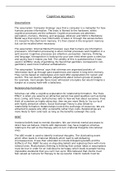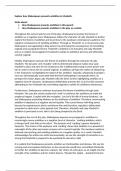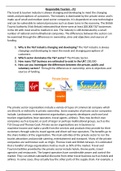Knippenberg, Dreu & Homan
Teams have become more diverse in terms of their demographic composition over the years and this
will continue. In addition, companies are increasingly using cross-functional teams, which means that
the teams have a higher functional diversity. Diversity has both positive and negative influences upon
performance.
Diversity refers to the differences between individuals on any attribute that may lead to the perception
that another person is different from self. Those attributes refer to an almost infinite number of
dimensions. Broadly, it can be separated in 2 categories:
Social category diversity: differences in readily detectable attributes, such as sex, age and ethnicity.
Informational/functional diversity: differences in less visible underlying attributes that are more job-
related, such as functional and educational background.
There are two main traditions in research in work-group diversity and performance:
The social categorization perspective: similarities and differences are used as a basis for categorizing
self and others into groups, with ensuing categorizations between one’s own in-group and one or
more out-groups. In-group members are mostly more trusted and consequently favored. This can
lead to inter-subgroups within a work group. Therefore, the more homogenous the group, the
higher the member commitment and group cohesion, and the higher the performance.
The information/decision-making perspective: diverse groups should outperform homogenous
groups. Diverse groups are more likely to possess a broader range of task-relevant knowledge, skills
and abilities that are distinct, which creates a larger pool of resources. Furthermore, they are more
likely to have different opinions and perspectives on the particular task, which leads to negotiating
and to more thoroughly processing task-relevant information and may prevent the group from
opting too easily for a consensus choice. In addition, the differences may lead to more creative and
innovative ideas and solutions. This leads to higher performance in the end.
Analyzing both sides, one could conclude that diversity negatively affects relationships within a team,
and positively affects the performance of a team. However relationship-conflicts lead to lower
performance, so not completely true.
Social categorization is more likely to occur for readily observable characteristics as sex and ethnicity,
than for more ‘hidden’ dimensions of diversity, such as functional or educational background. The
positive effects of diversity are linked to the latter. Therefore, you can also argue that diversity has only
positive effects on performance through informational differences, through underlying-job related
attributes. However, research show different results on this hypothesis.
Previous research failed to find the relation between diversity and group performance. To address this
problem, the article proposes the categorization-elaboration model (CEM). The CEM identifies a number
of reasons, why diversity research has yielded such inconsistent findings:
- Diversity research has paid insufficient attention to group information processing and to
important moderators of group information processing.
- Diversity research has often worked from a somewhat oversimplified conceptualization of social
categorization process (in-group versus out-group). This led to ignoring important moderators of











